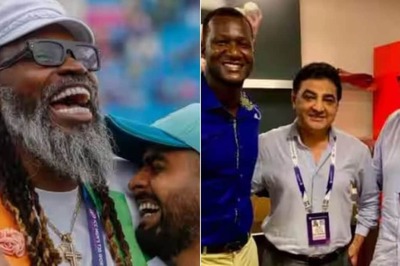
views
“Young soldiers carry ammunition in their pouches,
the older ones carry chocolates” -GB Shaw
The much-awaited new system of recruitment in the Armed Forces named Agnipath was launched with fanfare last week and has met with opposition not only by the veteran community, but also the youth of the country. Large-scale protests have been held in Bihar, Telangana and Haryana — the three states having sizeable representation in the Armed Forces. The scheme is allegedly steered by an Indian Foreign Service officer from the Prime Minister’s Office (PMO) and has been steam rolled on the services.
The scheme essentially is based on Tour of Duty (ToD) basis, which is prevalent in certain Western countries such as the USA and Israel. It certainly is prevalent in all the countries where conscription is compulsory and the ToD varies from six months to two years with lesser tenures in western countries like the UK, Austria and Australia and longer ones in Koreas, Ukraine and Russia. The ToD could be further reduced when the troops are deployed oversees. The United Nations Peacekeeping has reduced the TOD from one year to six months while carrying out reforms in the last decade.
The Agnipath scheme essentially is based on a four-year ToD for the age group of 17.5 to 22 years. The conscripts will have to go through the time tested existing system of selection including a computer-based written examination called Central Entry Exam (CEE), physical tests and medical examination. After a six months’ training period, they will be allocated their duty stations and are likely to have two duty stations in four years.
In the existing system of recruitment, the 12.67 lakh-strong Indian Army, the largest of the three services, recruits around 60,000 soldiers every year conforming to the number of soldiers retiring in the age groups of 35 to 45 years depending on the rank they have achieved. In the last two years, quoting the restrictions imposed by Covid-19, the Army has not recruited any soldier. However, it had gone through the mechanics of carrying out physical tests and the medical inspection of nearly 1.5 lakh aspirants. The last bastion, the written CEE, was cancelled one day before the exam and ever since the examination has been postponed.
The youth are protesting for three reasons: first, they have been preparing for the CEE examination for a long time but firm dates have not been given by the government; second, in the intervening period, some aspirants have become overage; and last but not the least, these aspirants had applied for a permanent job but the terms and conditions have been changed midway during their selection. The government has plans to reduce the size of the Indian Army by nearly two lakhs, bringing it down to nearly 10.80 lakh soldiers.
There are reservations and misgivings amongst the serving and veteran communities that the performance of these young ‘mercenaries ‘will not be up to the mark. Having seen the Israeli Defence Forces (IDF) operating from close quarters for nearly three years, I have a different take on the issue. The conscripts aged between 18 and 21 were the backbone of the Israeli Army and bear the brunt of any enemy attack till the reservists are called in. However, the levels of motivation and the stakes are different in both the contexts. Interestingly, these IDF soldiers carry weapons home every night and there has been no case of fratricide.
When I was commanding my unit, Napier’s Rifles on the Line of Control (LoC) in Bhimber Gali Sector between 1997 and 2000, the finest operation where eight infiltrating terrorists were eliminated without a scratch to own troops was because the young soldier with less than two years of service was very vigilant and silently and intelligently raised the alarm without alerting the infiltrators. Therefore, I have tremendous confidence in the spirit and fighting prowess of the highly motivated young soldiers.
Consequent to the violent reactions to the scheme, the government has tried to give certain concessions in form of one-time waiver of the age limit and assurances of lateral induction of Agniveers into the Civil Police Officers (CPOs) and Assam Rifles by the home minister as also into the civilian defence organisations of ministry of defence by the defence minister. It seems the government had not learnt lessons from the sudden introduction of demonetisation and farmers’ stir. The stakeholders should always be taken on board. Half-baked, life-changing schemes such as the Agnipath should have been test bedded for about 10,000 soldiers for two years after sending them to different types of units. The user, the armed forces, should have been taken into full confidence and the scheme should have been evolved after due deliberations.
With all due respect to the IFS officer in the PMO, it is not ‘one-size fit all’ solution that the officer may have studied about some western armies during his postings abroad. Most of the western armies were downsized after the Second World War and have small standing armies in absence of porous borders with inimical neighbours. The UK has an army of 1.4 lakh troops whereas France has 2.4 lakh. Germany, the third largest army in Western Europe, has around 1.8 lakh soldiers. All others have between 15,000 to 25,000 troops who are mainly used for military diplomacy, natural disasters and UN peacekeeping forces. Italy employs its Military Police for protection of national monuments during peacetime. Besides the Koreas and Vietnam, India is the only country which has CPOs and PMFs almost twice the size of the standing army with no direct responsibility of guarding the borders.
India, however, has nearly 4,000-km unresolved border issues with our Northern and Western adversities. If the government can ensure ‘one border, one force’ formula and give responsibilities to the Border Security Force (BSF) and Central Reserved Police Force (CRPF), who have been raised and expanded for these duties, then the Indian Army can even be reduced to a half million Army with five to six crack divisions in the form of Rapid Reaction Forces fully equipped in all capabilities including strategic airlift or movement through blue waters to carryout ‘Out of Area’ contingencies. Are we anywhere close to it?
The whole exercise seems to have been gone into for the reduction of the pension bill and providing employment to the youth of the country. The paramount issue of national security has been given a backseat. If the flab of the Defence Civilians working in the MoD is reduced or their pension is put under some other head, the budgetary allocation of pensions will reduce from 22% of the defence budget to 18%. The government has done well in privatising the white elephant in the air called Air India. It is time to prune the 2.5 lakh defence civilians in the defence ministry who all retire at 60 years of age and are inflating the pension budget. It is another case of missing the woods for the trees.
Lt Gen IS Singha was the Head of the Mission and Force Commander of the UN Peacekeeping Mission at Golan Heights between Syria and Israel from 2012 to 2015. The views expressed in this article are those of the author and do not represent the stand of this publication.
Read all the Latest News , Breaking News , watch Top Videos and Live TV here.


















Comments
0 comment